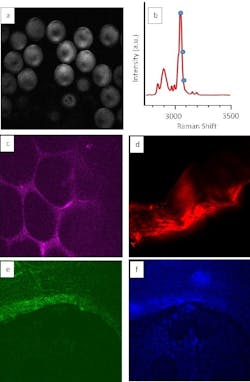New optical source design simplifies CARS microscopy
Coherent anti-Stokes Raman spectroscopy (CARS) enhances what are typically small Raman signals so they’re detectable above the noise background. Coupled with appropriate optomechanics, CARS provides images of the microscopic chemical distribution within a sample. It requires two simultaneous, overlapping pulsed laser beams, traditionally provided by picosecond optical parametric oscillators (OPOs), which perform well as CARS sources, but are expensive and require a dedicated optics lab. Research Fellow Konstantinos Bourdakos and his colleagues at the University of Southampton (UK) have now replaced the picosecond OPO with a laser diode-seeded optical parametric amplifier (OPA)—a simpler, smaller, less expensive alternative.1
Label-free molecular identification
When a photon interacts with a molecule, most commonly it scatters without changing wavelength. In Raman scattering, the outgoing light changes wavelength in an exchange of energy that leaves the molecule in a different final vibrational state. If the final vibrational state has higher energy than the initial, the scattered light is a longer-wavelength “Stokes” signal; if the final state has lower energy, it’s a shorter-wavelength “anti-Stokes” signal. The signal frequencies depend on molecular structure, so Raman signals provide molecular signatures with no labeling. This is desirable because attaching reporter molecules is both time-consuming and expensive and it can potentially modify the native molecular configuration.
But Raman signals are much smaller than other scattering and background effects. CARS overcomes the problem by sending two beams through the sample simultaneously. When the energy difference between the two beams—the pump and Stokes beams—matches the energy of a molecular vibration, a significant fraction of the population of molecules is elevated to that excited vibrational state. The pump beam then elevates those excited molecules to another virtual state, and when they return to the ground state, they emit a much larger anti-Stokes signal. Spectral filtering further reduces the background and coupling with scanning microscope optics producing an image whose intensity variations map the presence of a particular vibrational mode. Repeating the scan at different energies in the “fingerprint region”—a spectral spread around 2845 cm-1—produces a microscopic map of molecular distribution without any external labeling.
The conceptual simplicity hides some challenges. CARS is a third-order nonlinear effect that requires high peak power, which pushes toward the use of ultrafast lasers. But shorter pulses have wider spectral width, which reduces the spectral resolution and can increase the undesirable non-resonant background. Standard CARS microscopy meets these requirements by using a picosecond OPO as a source. However, OPOs are large, expensive, and require a dedicated optics lab to remain at peak performance. Other groups have demonstrated some simplification to CARS microscopy optical design;2 now, Bourdakos and his colleagues have taken that simplicity a step further, replacing the OPO with a picosecond OPA—essentially a single nonlinear crystal—seeded by a communications-wavelength laser diode.
Simple design, powerful imaging
Temperature control allows the laser diode to be tuned from 1562 to 1568 nm. A 1031 nm, 80 MHz, 2 ps pulsed laser is aligned with the diode beam seed and the two are coupled into the OPA, where energy from the pulsed laser is downconverted into the seed wavelength, spectrally filtered, then frequency-doubled with a second-harmonic generation crystal. The output beam has linewidth of about 5 cm-1, peak power of 2.1 kW, and a tunable range from 781 to 784 nm. That’s the pump for the CARS microscope. A small portion of the original 1031 nm picosecond laser provides the Stokes beam. Together, they access a spectral range between 3056 cm-1 and 3105 cm-1. Equally important, the resulting anti-Stokes beam is around 630 nm, well within their detector sensitivity. The researchers demonstrated their simplified source design capable of producing images of polystyrene beads and of adipose tissue.
To access the fingerprint region, the researchers replaced only one source of an existing CARS microscope with the continuous-wave laser diode-seeded OPA. This configuration halves cost and complexity, while still accessing a wide spectral range, putting the anti-Stokes wavelength around 730 nm, again suitable for their detector. They demonstrated the effectiveness of this configuration by imaging animal bone.
“We’ve demonstrated the ability to perform CARS imaging at standard frequencies with a system that’s much cheaper, more stable, requires no spectral compression, and takes up one-quarter or even one-fifth of the space,” says Bourdakos. The team demonstrated both second-harmonic generation and two-photon excited autofluorescence imaging with the source, and are working on extending to other refinements of CARS microscopy.
“This is an incremental advance,” Bourdakos adds, “but these kinds of results using a straightforward picosecond laser and a very simple laser diode-seeded source will significantly reduce cost and optical expertise required to perform CARS microscopy and consequently open it up to new users.”
REFERENCES
1. K. N. Bourdakos, Proc. SPIE, 11879, 1187903 (2021); doi:10.1117/12.2601570.
2. T. Steinle et al., Light Sci. Appl., 5, e16149 (2016); doi:10.1038/lsa.2016.149.
About the Author
Richard Gaughan
Contributing Writer, BioOptics World
Richard Gaughan is the Owner of Mountain Optical Systems and a contributing writer for BioOptics World.

